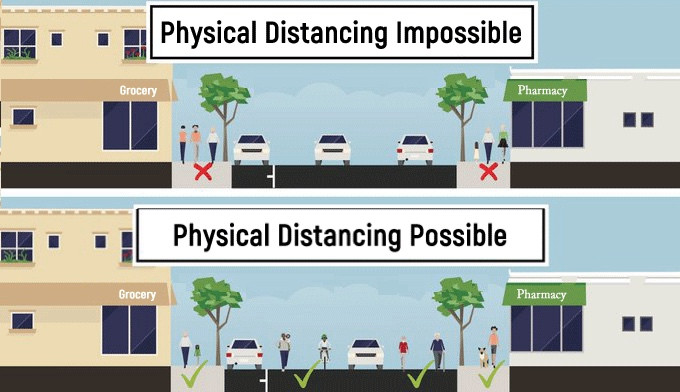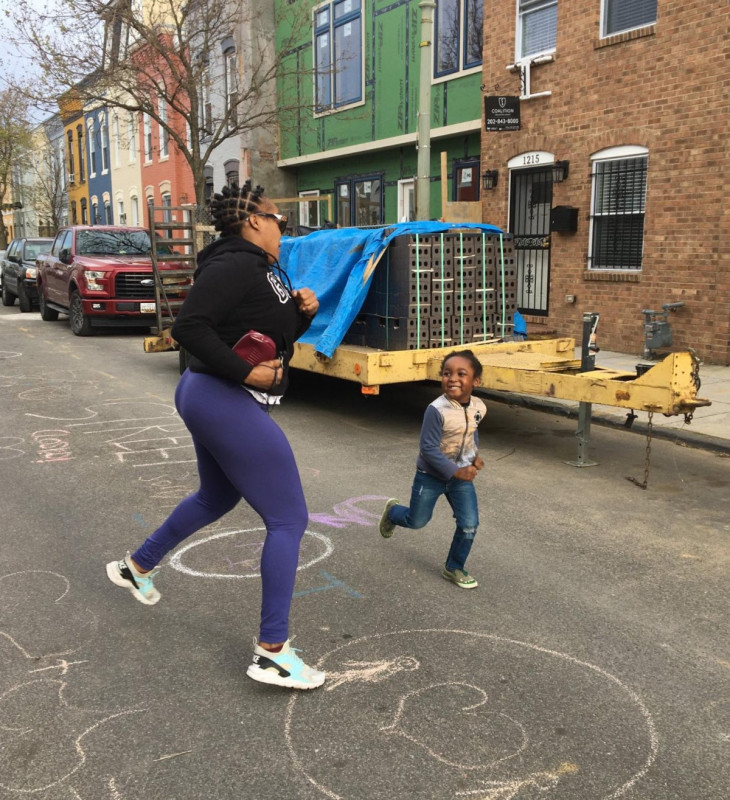This post originally appeared on Greater Greater Washington and is republished here with permission.

In an effort to provide more space for people outside while also adhering to the Centers for Disease Control and Prevention (CDC)’s social distancing guidelines, several DC residents are now placing traffic cones on neighborhood streets to effectively widen sidewalks.
Some of these cones include paper signs or chalk encouraging a “Pandemic Protected Sidewalk,” or a sidewalk extension making it easier for pedestrians to remain six feet away from each other.
This trend appears to have originated with a Twitter account calling itself the DC Department of Transformation, a “tactical urbanist organization that believes cities should be designed for people, not cars.”
We have our second Pandemic Protected Sidewalk! This one is at 17th and Church NW. #ExpandedSidewalks #PandemicProtectedSidewalk #SixFeetDistance #DazzlingDupont pic.twitter.com/Mc9f5Q6OUW
— Sultry and Sexy Department of Transformation (@DCDOTRA) April 8, 2020
The #WidenDCSidewalks hashtag on Twitter shows sidewalk extensions and limited road closures occurring in unison on 9th St NW, 17th St NW, 18th St NW, A St NE, Church St NW, Florida Ave NW, H St NE, Orleans Pl NE, and Wylie St NE.
Advocates are inviting neighbors to “continue to take actions ourselves until the city does their job of protecting citizens by widening sidewalks and reducing the speed limit across the city.”
They used their tweets to urge city officials to lower the speed limit in DC to 20 miles per hour because of the number of pedestrians having to move off sidewalks and onto roadways to maintain physical distancing while walking to work or grocery stores.
How residents are widening sidewalks
Among the advocates was Keya Chatterjee, a resident of Wylie St NE and leader of neighborhood group Safe Streets for Hill East and Near Northeast. She explained that she emailed neighbors asking for several temporary openings of the entire street to “give us a bit more space to stay apart since our sidewalks are only four feet wide in spots.”
According to Chatterjee, the Wylie St NE neighborhood placed one cone at each end of their one-way residential street. Regarding essential vehicle access, she added, “We had a vet tech and a delivery person ask to go through and we cleared out the kids and they drove carefully.” She emphasized, “it took us just two cones to make it happen!”
Delayed DC government response on space for physical distancing
The CDC recommends physical distancing and remaining six feet away from others to reduce the spread of COVID-19. New York, Philadelphia, Oakland, and other large cities have opened dozens of miles of streets to people, restricting private automobile access besides emergency vehicles, for this reason.
Before April 10, DC Mayor Muriel Bowser repeatedly demurred on opening streets, citing concern about creating a “festival-like environment.” Bowser may have been referring to the inaugural OpenStreetsDC event in October 2019 where hundreds of people walked, biked, and rolled up and down three miles of Georgia Ave NW.
On April 11, Bowser announced that the National Park Service would open Beach Drive as well as some roads in Anacostia Park and Fort Dupont Park, all on parkland owned by the federal government. However, Bowser did not discuss roads or sidewalks owned by the District government.
Coronavirus and narrow sidewalks, in contrast to the OpenStreets DC festival and existing parks, affect the entire population and especially those most vulnerable to the impacts of the pandemic.

Walking and socioeconomics
Sidewalks on DC’s most densely populated streets, including Martin Luther King Jr. Ave SE, Alabama Ave SE, and Benning Rd NE/SE, are frequently less than five feet wide. All of the aforementioned sidewalks also abut roads with at least four lanes (48 feet) dedicated to automobiles or parking and are located in majority-Black neighborhoods. Car traffic is significantly lower during the pandemic, which delivers striking images of crowded sidewalks astride nearly empty roadways.
This was Rock Creek & Potomac Plwy NW this evening.
— Randy Downs (@RandyDaleDowns) April 8, 2020
Any thoughts on this he allocation of public space? 🧐 pic.twitter.com/sVrExwn1JG
The imbalance of space presents health challenges to citizens wishing to follow the six-feet rule. These sidewalks also serve many food markets, low-income populations, and essential employees walking to and from bus stops as well as work. Navigating around people on these sidewalks requires briefly stepping into driving lanes or moving down side streets.
Walking and climate
New York Times reporter and DC resident Lisa Friedman reported last week on research from Harvard University showing that the poor air quality is increasing the likelihood of deaths from coronavirus, saying, “The District of Columbia, for instance, is likely to have a higher death rate than the adjacent Montgomery County, Md.”
In DC, most air pollution originates from mobile sources like automobiles and trucks. The Harvard study, which accounts for data from 3,080 counties and effectively reports for 98% of the population, suggests a causal connection between air pollution and deaths from coronavirus.
By encouraging residents to walk rather than drive, DC could further reduce the air pollution within the city. The Federal Highway Administration shows that 33.0% of car trips are less than two miles and 20.1% are less than one mile.
Walking and recreation
The activists behind #WidenDCSidewalks also tout safe recreation and exercise. Chatterjee said she “received universal support for giving kids a little space to run and bike,” and “agreement from neighbors that we all keep more than six feet of distance and try to keep faces covered as well.”

A movement grows for opening DC streets
Support for open streets in the District has been growing. DC Councilmember Charles Allen (Ward 6) wrote in a letter to DDOT:
“I am writing to urge the District Department of Transportation (“DDOT”) to consider how all of the District’s public space can be used to provide opportunities for District residents to responsibly leave their homes during the period of Mayor’s Order 2020-54 (“Stay at home order”).
In particular, I request that DDOT identify streets that are suitable for closure to car traffic — on a full- or part time basis — so that District residents can safely walk, run, bike, stroll, and scooter in our public space.”
Several other organizations have called on Bowser to enact physical distancing by widening sidewalks or opening District streets entirely to people biking and walking: DC Pedestrian Advisory Council, DC Bicycle Advisory Council, DC Families For Safe Streets, and Advisory Neighborhood Commission 6A.
On April 3 about 700 DC residents also signed an open letter requesting space for social distancing.
The Bicycle Advisory Council letter also singled out Connecticut Ave NW, East Capitol St NE/SE, Southern Ave SE, Mississippi Ave SE, Irving St NE/NW, and H St NE as further opportunities to rebalance some space from automobiles to people. The letter also underscored access to the hospitals on Irving St NE/NW and Southern Ave/Mississippi Ave SE in light of the large number of DC residents who do not own a car.






